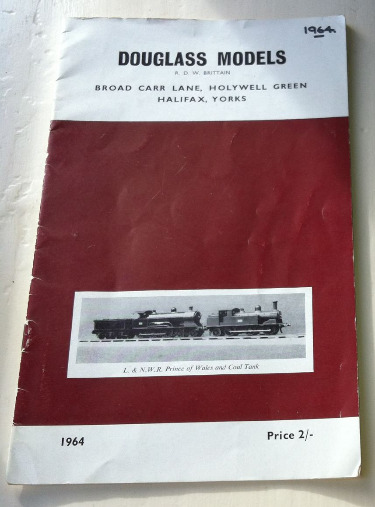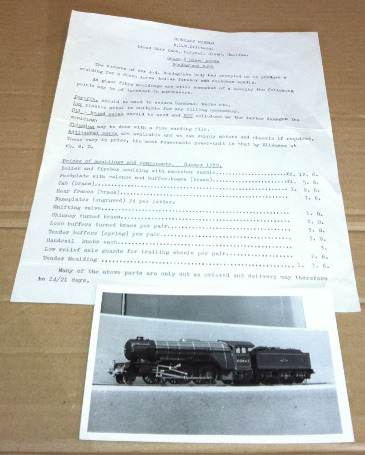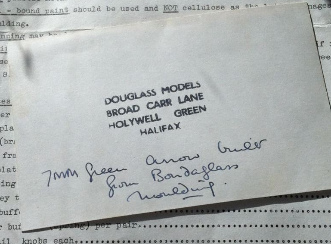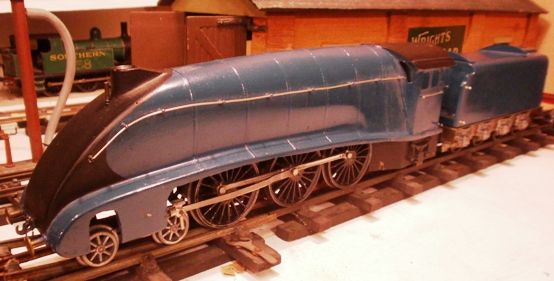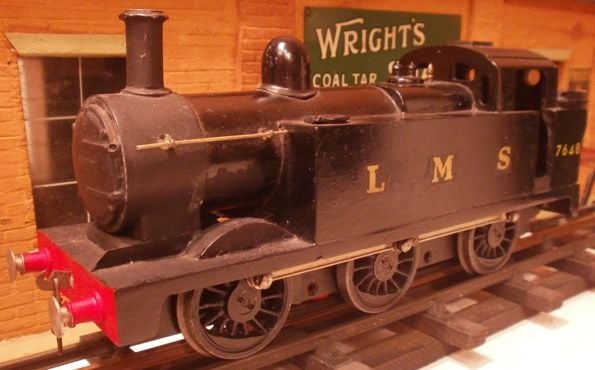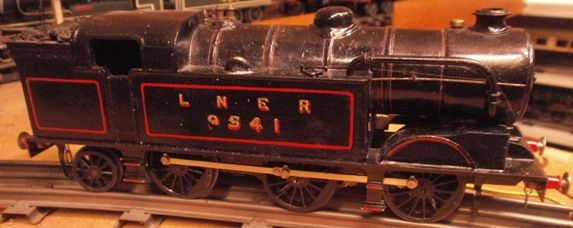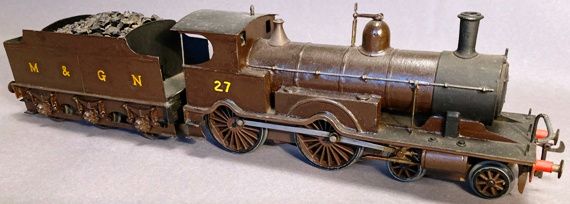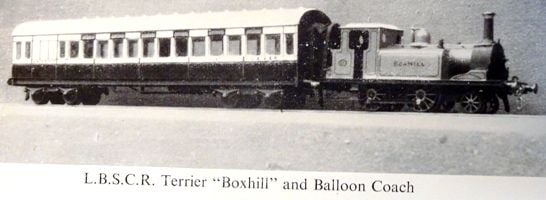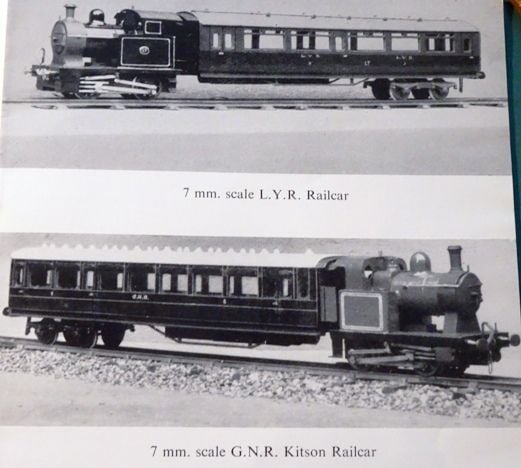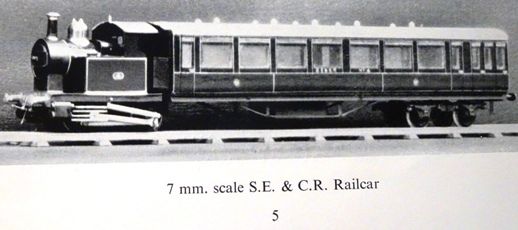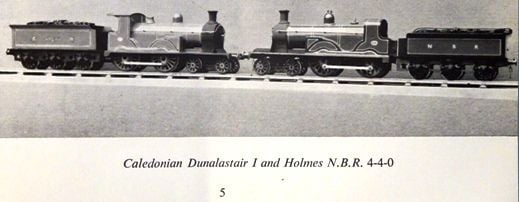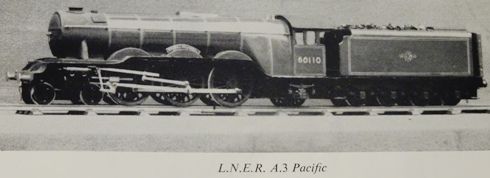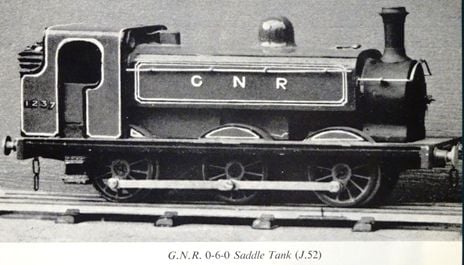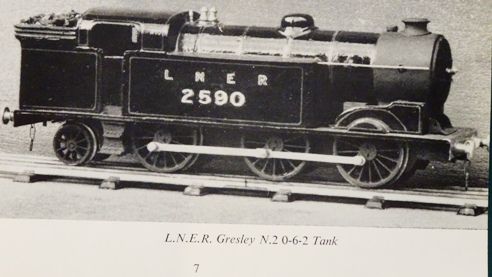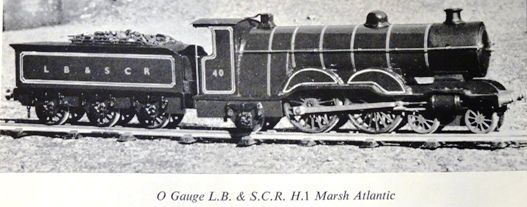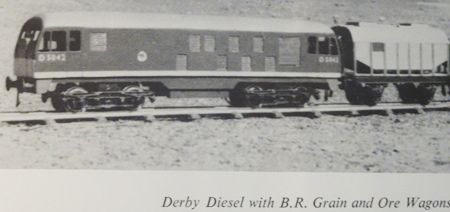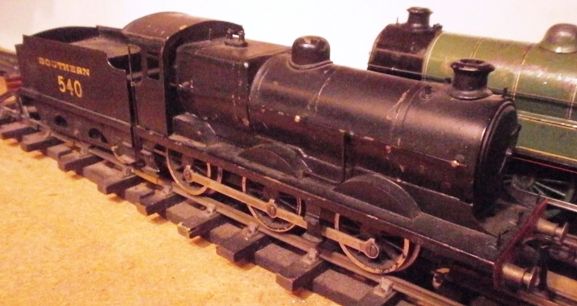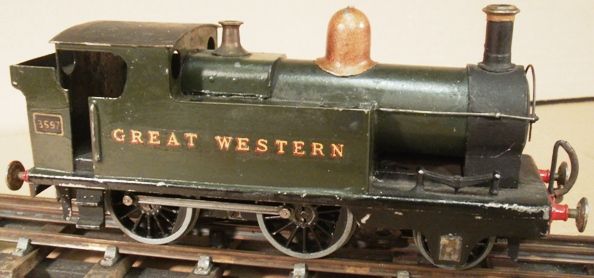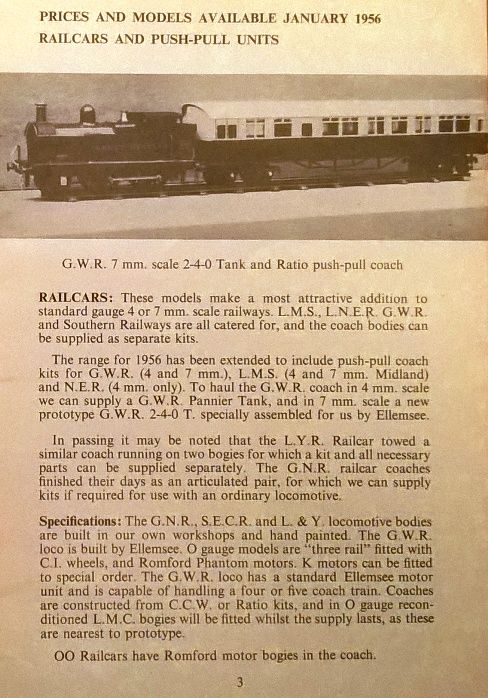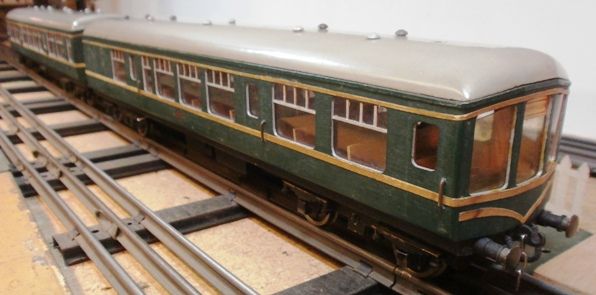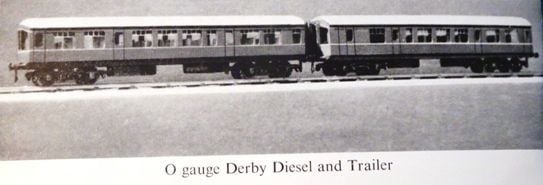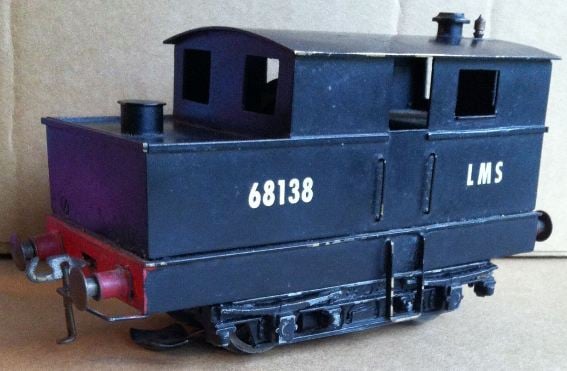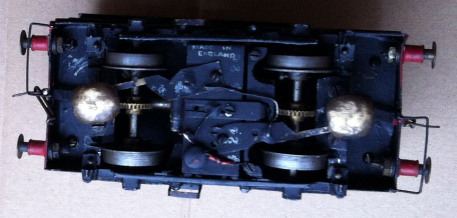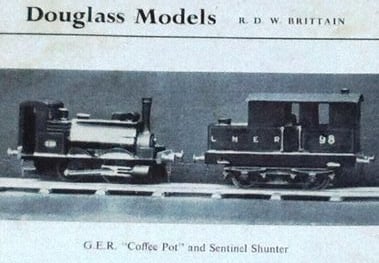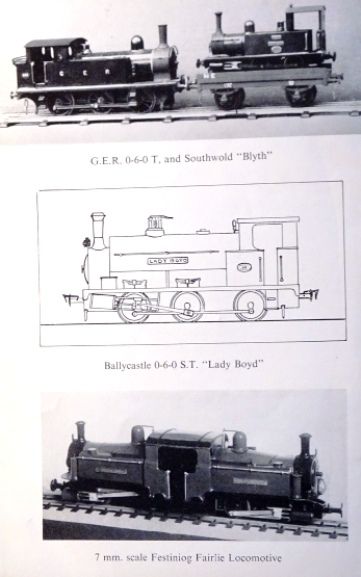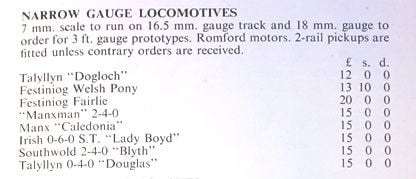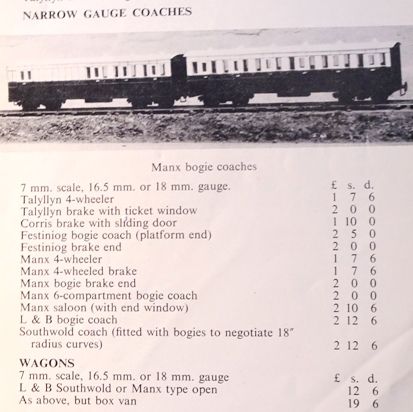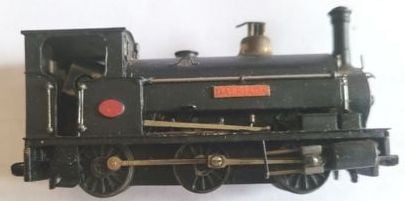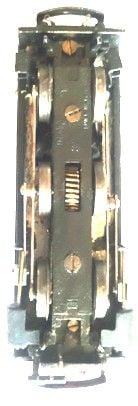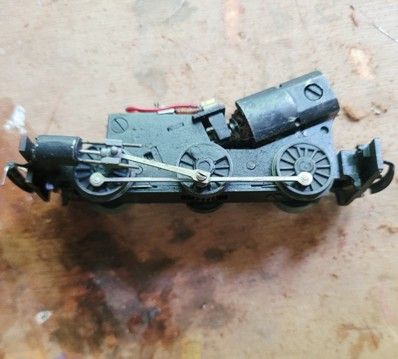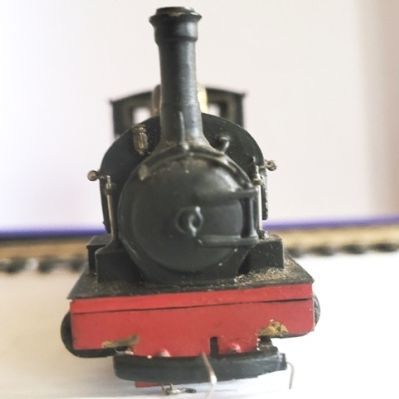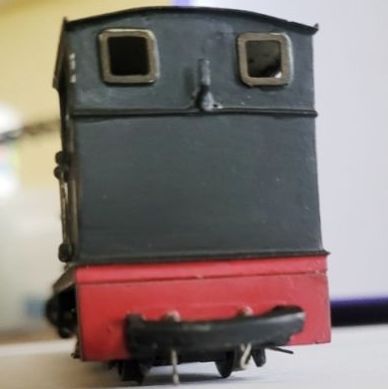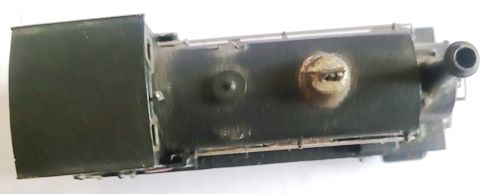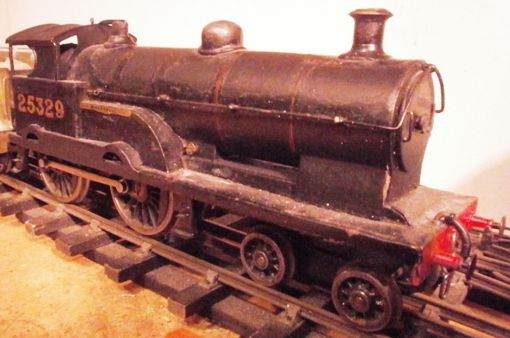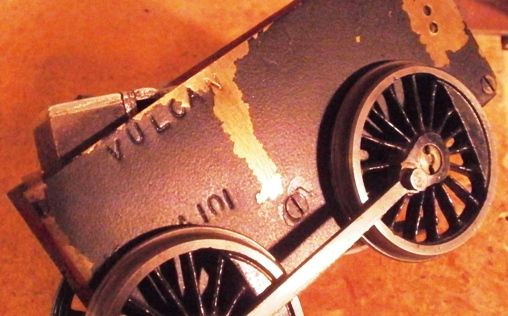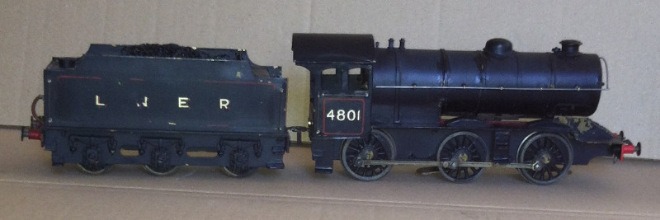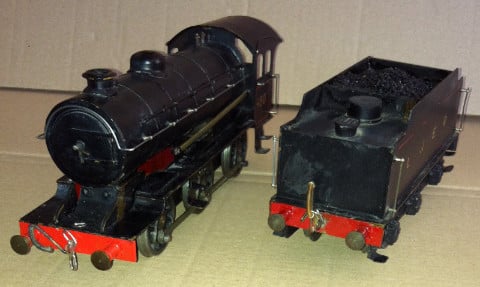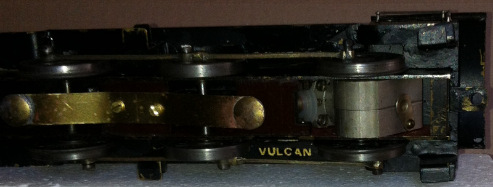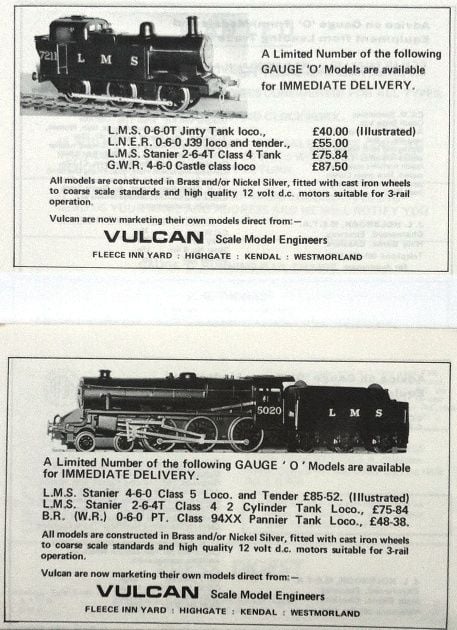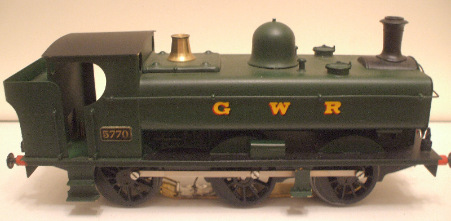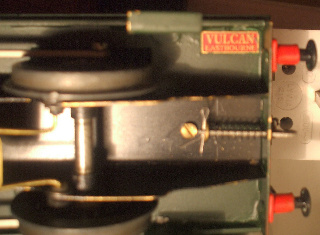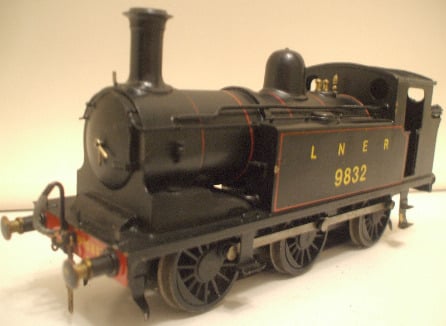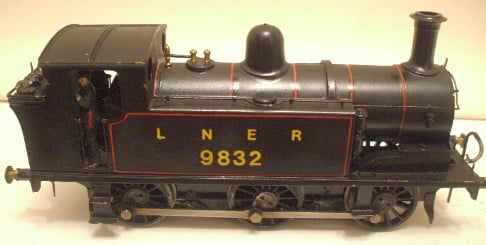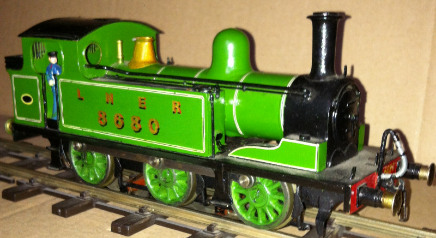
Douglass Models & Vulcan of Kendal**** Material in this section was most recently updated in March 2025 ****
The locomotives of two post-war producers
Copyright is retained by M.L.Harrison for all text and photos, except for those taken by other owners and enthusiasts.
M.L.Harrison 2020, 2025 © All rights reserved.
The purpose of this section of the website is to present some images and comments on products produced by two of the small firms that came into being in the earlier post-war years. They helped fill gaps in what was available 'ready-to-run' in 0 gauge at relatively modest prices, at a time when tinplate tab-construction by Hornby and others was past its peak, and when there was a demand for more realism and diversity.
Douglass Models locomotives This was a Halifax firm that produced locos and rolling stock, and also seems to have sold some second-hand items. For some of their coaches, see our separate section about Coaches by Other Makers. The locomotives range included a number of engines put together by using "mouldings ... made from glass fibre", to which brass fittings could be added. Kits were available for building these "Bondaglass" models, which included a "Green Arrow" V2 2-6-2 and a Gresley A4 pacific (see Illustrations D1c, D2a, D2b, D3 below). These products are fairly well known amongst 0 gauge enthusiasts, and represented a pioneering approach by the company. More conventional materials were also used, including brass. One of the interesting wooden items made alongside the firm's coaches was a BR diesel railcars/multiple units set (see Illustrations D10a and D10b below). Douglass Models also offered a range of small narrow gauge engines, and we have included some examples of these at the end of our coverage of the firm.
Illustrations D1a-D1c. Two of the catalogues produced by this firm, together with a photo of a 'Prince of Wales' class model of the type shown on one of these covers. Many thanks to the person who let me have the picture of this model, which seems quite a scarce item.
Illustrations D2a and D2b. The top illustration here features a postcard-style picture of the firm's V2, and the picture may well have been supplied along with a Bondaglass kit and the instructions. The address and the comment below it are on the reverse of the card.
Illustrations D3, D4, and D5. Three other models from the Bondaglass range; the A4 (being restored when the photo was taken), an LMS 'Jinty', and an LNER N2 0-6-2 tank. I am grateful to the owner of these models for providing these photos and several below. An 'official picture' of a Douglass A4 can also be seen in Illustration D1c above.
Illustration D6. This is another loco from the range, a pre-grouping engine that would have been an appropriate companion model for the M.& G.N. 0-6-0 that follows below.
Examples from the range as offered in the firm's catalogues
Illustrations 7a-7k. These images have been drawn from a number of the firm's catalogues to give an idea of the variety and convincing style of the engines being offered. Specific items amongst these models remained in the catalogues for several years.
Illustration 7l. The firm sold various other items, including these models.
Douglass Models rebuilt some commercially-made locos into engines they could offer as their own. The 1960 catalogue, for instance, refers to conversions of the Bassett-Lowke "Maid of all Work" (a non-prototypical 0-6-0 tender loco) into M.R., G.N.R and M.& G.N. models (see below). In addition, there is a Southern Railway loco that I think perhaps was produced by them in the same manner (see also below), although I have not yet seen any catalogue image of this.
Illustration D8a. A Douglass catalogue image (1960) showing an example of a rebuilt B/L loco, and referring to others also available.
Illustration D8b. A Douglass M. & G.N. 0-6-0 tender loco made by converting a Bassett-Lowke standard type of 0-6-0. The LNER eventually took such locos over from the M. & G.N. (and one that survived until 1942 is shown at p.53 in Casserley, H.C., LNER Locomotives 1923-1948, Bradford Barton, 1977).
Illustration D8c. A similar conversion, this time into a Southern Railway loco (see comments above).
I have been informed that at one point Douglass Models offered a GWR tank locomotive that they indicated was being supplied by or through collaboration with Leeds Model Company. Many thanks to the owner of one of these very rare models for providing a picture of it (see Illustration D9a below), together with a Douglass catalogue extract referring to the item (see Illustration D9b). For a project by an enthusiast that generated an excellent reproduction version of this model, see our website section on vintage locos and motors by other makers.
Illustration D9a. Douglass Models GWR 2-4-0 tank loco, which the company indicated was produced with the involvement of LMC. This model was shown with a "push-pull" coach in a Douglass catalogue from 1956 (as seen in the next illustration), being described there as a new prototype GWR 2-4-0 tank "specially assembled for us by Ellemsee". A contemporary small advertisement in Railway Modeller referred to this engine in the context of a branch train, and indicated that the "2-4-0 tank loco (Ellemsee)" cost ten pounds ten shillings, or five pounds five shillings as a set of parts (6, 61, November 1955, p. xii). Apparently Douglass also offered a Midland Railway 0-6-0 tank made to order from Ellemsee parts around this time, and an LNWR Nineteen inch goods loco that was a rebuilt Marklin model (see Railway Modeller, 7, 68, June 1956, p. viii).
Illustration D9b. A Douglass Models catalogue extract presenting the type of loco shown in our previous illustration.
Illustration D9c. I understand that in 2024 the owner of the above 2-4-0 tank loco managed to locate a correct matching vintage coach to go with the engine. Thanks to this enthusiast for letting us have a picture of the two together.
Illustrations D10a and D10b. The first photograph here shows a Douglass British Railways diesel railcars/multiple units set, built in wood and fitted with a powerful Bond's motor bogie. Thanks to the owner of these vehicles for supplying the illustration. The second image is from a Douglass catalogue (1959).
Some of the Douglass Models engines were built from brass, and their Sentinel shunter was one of these. It was fitted with what the company described in their 1960 catalogue as a 'powerful Ellemsee motor bogie'. The sturdy model pictured below appears to be one of these Douglass locos. The ex-LNER BR number does not seem to fit with the LMS lettering (the kind of mismatch that can confirm commercial manufacture rather than something built by an enthusiast). The underside of the LMC motor bogie has been labelled by hand to refer to the item being made in England, and carries what is probably a serial number.
Illustrations D11 and D12. This appears to be the Douglass Models version of a Sentinel shunting loco catalogued at the end of the 1950s. It was good value for money (priced at £8 in 1960). I think that although it is plain rather than detailed it is a very attractive item. It runs at closer to a scale-looking speed than many other three-rail locos, although it may need a centre rail set fairly low to ensure clearance.
Illustration D13. A sentinel alongside another of the firm's brass locos, shown here on part of the cover of the 1958 catalogue. The model in the catalogue picture differs slightly from the example shown above.
Narrow Gauge Douglas Models was unusual in offering a significant array of items based on narrow gauge prototypes over quite a long period. It seems that early on (in or around 1950) they took over a range produced by another company. This was SuperScale Models (and we note a report referring to that change in our coverage of locos by other vintage makers). We reproduce below a page from a 1958 Douglass catalogue which includes photographs of two examples of their narrow gauge engines, along with a drawing. We also show the catalogue's lists of the narrow gauge locos and rolling stock on offer at that time. A different but related model is shown lower down this page.
Illustrations D14-D16. Extracts from a 1958 Douglass Models catalogue.
I understand from Alan O'Rourke that the prototype for the Douglass loco 'Dalriada' shown below was from the same Irish railway as 'Lady Boyd' shown in the drawing above. It was one of two Black Hawthorn 0-6-0 STs built in 1880 that ran on the Ballycastle Railway. Alan has explained that a third loco, the slightly smaller 'Lady Boyd', was built in 1879, and was acquired from the contractors who built the line. He has reported on Dalriada's construction and background in an article,'Dalriada: a vintage Irish 00n3 model'. This appeared in the November 2023 issue of New Irish Lines (10, 2, pages 42-43). It includes helpful details about materials, construction, and the mechanism that was utilised. The article can be found in the archive at https://newirishlines.org/archive/ Having calculated the present-day equivalent for the prices charged by Douglass when these models were made, Alan has suggested that they were aimed at the higher end of the market. With his permission we reproduce below not only his photographs but also some of his specific comments on Dalriada's construction and materials.
Illustrations D17-D23. I am grateful to Alan O'Rourke for these photographs of a Douglass Models loco from the firm's narrow gauge range. The company made several different narrow gauge loco models as well as coaches and wagons. See above for reference to a published piece by Alan about this engine. Alan has commented as follows on this model: "I had ... assumed such models would be made to order from brass, but this one is from a chunky but crisp set of castings, rather better detailed than the Ks kits of the period, and on reflection it seems obvious that if Douglass Models planned to make more than one, they would have prepared moulds. I am guessing that they provided a chassis for each engine and the Ks motor was probably the only one available at the time small enough to fit such a modest-sized prototype. My [loco] runs on a Tri-ang TT Jinty chassis. ... the builder has made a pretty good job of fitting cylinders (like the rear buffer beam these are part of the chassis) connecting rods and motion. ... my guess is that when Douglass ceased trading, they sold the moulds to GEM ...". Another enthusiast has provided photographs of some other Douglass narrow gauge items in his collection, and we show these now. A Fairlie was included in the firm's catalogue list shown above, priced at £20.
Illustrations D25-D30. Many thanks to the enthusiast who has sent these images from his collection. The catalogue extract above shows how expensive these engines would have been when supplied. Even so, it seems possible that not all that many have survived.
Vulcan of Kendal (and Eastbourne) Vulcan of Kendal is a firm that is known today partly because it took on some commissioned loco work for Bond's (a more longstanding company referred to in our section on vintage locomotives and motors). Vulcan was a company that aimed at providing well-built 0 gauge locomotive models mainly for 12 volt 3-rail coarse scale, although (as an advertisement from 1972 also makes clear) items could be supplied in fine scale or 2-rail 'at no extra cost' (see Gauge 0 Guild Gazette, IV, 13, January 1972, p. 30). Models were relatively plain by today's standards, but solid and well designed. The company also rebuilt some Bassett-Lowke models, and seems sometimes to have fitted them with its own German-made motor and gearbox. These rebuilds included three 4-4-0 tender engines; an LNER D20, LMS 'George the Fifth', and LNWR 'Precursor'. An example of one of these is shown immediately below, followed by a picture of its mechanism. Thanks to the owner for providing these two photographs.
Illustrations VKE1a and VKE1b A Vulcan of Kendal rebuild of a Bassett-Lowke 4-4-0 tender loco, together with the mechanism.
I know of only two good printed sources for information on Vulcan and its locomotives (although of course there may also be others that I have not seen). The first source is a very useful, well illustrated and substantial account by the late Alan Cliff of the firm and its output (see Model Railway Enthusiast, 6, 4, April 1999, pp.24-25). Alan Cliff discusses therein Vulcan's contract to build J39 0-6-0 engines for Bond's, along with a smaller order from Bonds for some B1 4-6-0s, and a commission to refurbish 'Bonzone' tanks. His article also lists nine other loco types sold under Vulcan's own name. These were apparently a Fowler 3F Jinty tank, a Black Five 4-6-0, a Stanier 2-6-4 tank loco, a GWR Castle, a GWR 94XX pannier tank, a Southern Q Class, an LMS 2P, a Southern T Class tank, and a continental 4-6-0 loco. The history provided is then completed by information on what happened after Vulcan of Kendal ceased production, when the proprietor re-launched loco-building under the name of 'Vulcan Models Eastbourne'. Some small tank engines were then made, including a GWR 57XX pannier tank, a Southern G6, an LNER J83, and an LMS 3F Jinty. A second (although much shorter) source of knowledge is a 'Trade Topics' review from G.F. Rice in the Gauge 0 Guild Gazette in 1971 (IV, 10, pp. 18-19). This shows the pictures the company will have provided to the then reviewer, of an LMS 2P and a J39, the latter being sold under Vulcan's own name (as well as through the Bond's commission). The list of locos 'in production' at that point included the J39 and the 2P, as well as an LMS 4F, an LNER J72, the 94XX pannier tank, and the Southern T Class tank. The firm had fitted a Pittman motor (a DC 81) in the tank loco sent as a sample, and was building in brass sheet. The reviewer commented that there were at that time very few ready-to-run locos on the market; and it does seem that they filled a longstanding need as well as representing good value for money. To illustrate for interested readers who do not own any Vulcan models, some photos of models and a couple of advertisements are shown below. The first loco is one of the J39s, probably the best-known and most numerous items amongst what was produced. It is unusual in being a model sold directly by Vulcan, rather than one of the locos sold through Bond's.
Illustration VKE2 Vulcan of Kendal J39. These LNER models seem well-regarded, perhaps not only because they were nicely made but also because Bond's commissioned and sold most of them. This particular example had some damage at the front end that was put right by an enthusiast. It still needed some tidying up of its previously 'touched-in' paintwork, and of its lining (which has been partly lost). When advertised in 1972, a J39 cost £55 if supplied directly by Vulcan. When the arrival of the Bond's version had been announced in a 'Trade Topics' report in the press in 1970, the price mentioned from Bond's had been £66 (Gauge 0 Guild Gazette, IV, 7, July, p. 14). The Bond's locos would of course all have had Bond's mechanisms, but so too does the Vulcan loco shown above.
Illustrations VKE3a and VKE3b. Two more photos of the J39 pictured in Illustration VKE2. The lower image is just to show the company's painted or transferred label as applied when at Kendal. In our page on Bond's locos we show a J39 by Vulcan that would have been sold through Bond's.
Illustrations VKE4a and VKE4b. Two Vulcan advertisements from 1971.
Illustrations VKE5a and VKE5b A Vulcan pannier tank from the later period of production, in Eastbourne. I am grateful to the owner of this model for providing these two photographs, and also for the two pictures below of a J83.
Illustrations VKE6a and VKE6b I believe that this handsome J83 tank is probably a Vulcan model; the pictures of it have been kindly provided by the same person who supplied Illustrations VKE5a and VKE5b above. Unfortunately, there seems to be no easy way of verifying the maker with certainty, a problem that can arise quite often with vintage post-war locos that seem to be professionally built but today have no surviving logo or trade mark. This LNER tank came from a collection in which there was also a second J83 that I acquired when the locos were offered through the Gauge 0 Guild's excellent E&T Service. Sadly, I no longer have that 'sister' loco, but - before eventually passing it on to a friend who wanted it - I showed it to someone who had done work for Vulcan. He confirmed that quality and style were consistent with what he had seen when with the firm. There is also a J72 from the same model railway collection that conceivably might be a Vulcan loco that has been repainted and had additional detail added. Clear verification is problematic in that case too ! The engine is shown below.
Illustration VKE7 I think this may be another Vulcan of Kendal loco, although I have no direct proof (see discussion immediately above). It has a Pittman motor and is made in brass. A previous owner (in the North-East of England) seems to have repainted it to represent an engine that was fully lined out for station pilot work at Newcastle Central. There is a picture of No 8680 in that livery in 1947, in Casserley, H.C., LNER Locomotives 1923-1948 (Bradford Barton, Truro, 1977), p.55. My photo has blurred the lining, which is better than it appears here.
|
